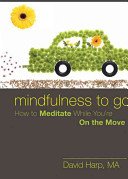 | Mindfulness to go: How to Meditate While You're On the Move A book by David Harp Published in 2011 Find in a Library |
Review of "Mindfulness to go: How to Meditate While You're On the Move"
American Buddhist Perspective
This is an excellent book for anyone "too busy to meditate," which these days seems like just about everyone I know. It's compact, light-weight (easy to carry on the bus-train-plane-etc), and divided into very quickly readable chapters covering the whole A-Z of mindfulness.
After a brief introduction (What, Why, and How), Harp gives us a discussion of the all-important fight-or-flight response. As he rightly points out, this physiological response to our surroundings evolved with us to keep us alive, but these days, due to the all pervasive nature of stressful stimuli, it is now starting to slowly kill us.Mindfulness, in this simplified, non-religious context, is just about putting a wedge between those stimuli and the chronic stress that they could lead to.
The book is unique in introducing mindful practice through walking first - not in various sitting practices as is most common. Walking is something all of us do every day, and it seems that the busier we are, the more walking we seem to have to do. And, as an aside, the more forgetful (less mindful) we are, the more we have to walk; as a Spanish friend of mine told me the other day, "in Spain, we have a saying, 'If you have bad memory, you have good legs.'"
By teaching mindfulness in walking, David Harp gives us a tool we can use any time, and quite likely when we most need it: when we're on the move. There are a couple chapters just devoted to walking meditation: different exercises, aspects of mindfulness, using the breath and so on. It is a step-by-step from the simplest techniques to the most refined. There is even a good sense of humor throughout, and perhaps a bit of tough love, as in the section "If This Seems Dumb, or Boring" which basically says, "too bad." He makes the point elsewhere that we're building a mental muscle, and just as with physical exercise, it can start off being pretty difficult, but, "it's always worth the effort."
Following this, we get to explore thoughts and emotions as part of the meditation practice. Here Harp conveys both cutting edge psychology and 2500 years of Eastern tradition in astoundingly clear and direct writing. In fact you'll rarely see any of the typical jargon of contemporary psycho-babble or Eastern technical terminology. Everything is boiled down to its pragmatic essence and stated simply, in terms that anyone can understand and practice.
The book culminates with several exercises, essentially building a mindfulness tool kit to be used on all sorts of situations of everyday life including conversations, sitting on the bus, eating, and even shopping.
The result is a book that I can very highly recommend to my 'busy bee' friends and colleagues who want a no nonsense guide to being more mindful, and thus joyful, in life. The only drawback I can think of is that it's just a book. And we all know how easy it is to get a book, read it, skim it, whatever, and then shelf it and forget about it. So I'd highly recommend reading Mindfulness to Go with someone: a partner, a good friend, or perhaps a book club or meditation group.

